Svenska Spindlar
Svenska Spindlar (German: "Swedish Spiders") by Carl Alexander Clerck from 1757 is the first comprehensive work on Sweden's arachnids and one of the first regional monographs of a group of animals worldwide. The work comprised 162 pages of text (8 of which were unpaginated ) and 6 color plates. It was published in Stockholm in Swedish with a slightly smaller formatted Latin translation. The full title was: Svenska Spindlar uti sina hufvud-slågter indelte samt under några och sextio särskildte arter beskrefne och med illuminerade figurer uplyste. - Aranei Svecici, descriptionibus et figuris æneis illustrati, ad genera subalterna redacti, speciebus ultra LX determinati.
For the first time in a zoological work, Clerck consistently applied the binary nomenclature for 66 Swedish spider species described in detail , which Carl von Linné had used for botany in 1753 and which he a year later in 1758 in the 10th edition of his work Systema Naturae for more than 4000 animal species presented.

Processing of arachnids
Conceived for the spiders that Clerck in the modern sense and harvestmen expressly excluded, he used a single generic name ( Araneus ) and added that each one species names added, which consisted of only one word. Each species was introduced in the Swedish text by its scientific Latin name, followed by information about when the animal was found and a detailed description of the eyes, legs and body. The differences between the sexes were also precisely described. Each species was illustrated in impressively lifelike drawings on colored copper plates .
Effect and meaning of the work
Due to the exceptionally thorough processing of the spider species, the species names proposed therein (which Linné adopted in Systema Naturae in 1758 with minor changes) have always been traditionally recognized as binominal in arachnology, which was later officially taken into account in the zoological nomenclature code. This means that in case of doubt, the spelling of a name proposed by Clerck in 1757 has priority over that of Linnaeus in 1758 (e.g. Araneus instead of Aranea ), and that Clerck's spiders are the first animals that are still available today in modern zoology scientific names.

Year 1757 or 1758
Traditionally, arachnologists used the year 1757 for the animal names described by Clerck, deliberately and successfully ignoring the fact that in zoological nomenclature no animal name in a work published before 1758 could generally be considered available. The spider names of Clerck were adopted by Linnaeus in 1758 and Linnaeus could easily have acted as an author. In arachnology, however, there was an insistence on Clerck's authorship, which possibly had to do with the fact that Linnaeus also occasionally cited other authors and, in the interests of the stability of the names, it seemed safer to rely exclusively on Clerck's descriptions. In addition, many of the animals described over 250 years ago and preserved in alcohol are still preserved today in the Naturhistoriska Riksmuseet in Stockholm and can be used for study purposes.
In 1999, as part of the 4th edition of the ICZN Code , it was decided that Clerck's name should be available, but to be quoted with the year 1758. This incorporated a contradiction in the ICZN Code, because on the one hand the publication date of Systema Naturae for 1 January 1758, on the other hand it was determined that Clerck's work (which is incorrectly cited in the ICZN Code Art. 3 with the Latin subtitle Aranei Svecici ) should be regarded as previously published. The question of how something could be published before January 1st but still in 1758 is not answered satisfactorily.
A serious contradiction lies in the fact that one of the most fundamental rules of zoological nomenclature is being violated. The actual year of publication is always given as the year for the name of an animal species. The ICZN code has stipulated an exception here since 2000. The new regulation was misunderstood by many researchers who believed that setting it to 1758 for Clerck's work and January 1 for Systema Naturae would have changed the priority. As a result, in 2007 even a case was brought before the ICZN commission , as the researchers were no longer sure whether the genus name should now be Araneus Clerck or Aranea Linné. In their opinion, the year 1758 for Clerck's spiders could be interpreted in such a way that the Linnean work published on January 1st now had to have priority. In 2009, the commission felt compelled, although this was already explicitly in the code, to make it clear once more that, according to the regulation, Clerck's name had priority and should be used.
Since the arachnologists had not adhered to the ICZN code before, it remains to be seen whether the year 1758 will actually prevail for Clerck's spiders. There is some evidence that 1758 is not unanimously accepted as the date, not even outside of arachnology. For example, in the AnimalBase database, which deals with all animal groups and where Svenska Spindlar was digitized in 2004, the year 1757 is deliberately used with references to the contradictions in the code and the misunderstandings and uncertainties that resulted from it after 2000. In Wikipedia, too, the actual publication date of 1757 seems to establish itself as the year for Clerck's spider species, both for the name Araneus (in the German, English, French and Italian versions, September 2010) and for the corresponding species names. Even Encyclopedia of Life , one of the central database of the Biodiversity computer science seems to favor in 1757 (as of September 2010).
References
- ↑ In the Swedish spelling of the time, the word Spindlar (= spider) was capitalized.
- ↑ Clerck, C. 1757. Svenska Spindlar uti sina hufvud-slågter indelte samt under några och sextio särskildte arter deskrefne och med illuminerade figurer uplyste. - Aranei Svecici, descriptionibus et figuris æneis illustrati, ad genera subalterna redacti, speciebus ultra LX determinati. - pp. [1-8], 1-154, pl. 1-6. Stockholmiæ. (L. Salvii).
- ↑ AnimalBase list of the 66 species of spider described by Clerck in 1757 (there are nominally 67 species names listed, Araneus w-insignitus and Araneus v-insignitus however refer to the same name; Clerck had written two superimposed v).
- ↑ ICZN Code Art. 3.1
- ↑ ICZN Code Art. 21.1
- ↑ Kluge, NJ 2007. ICZN Case 3371. ARANEIDAE Clerck, 1758, Araneus Clerck, 1758 and Tegenaria Latreille, 1804 (Arachnida, Araneae): proposed conservation. - Bulletin of Zoological Nomenclature 64 (1)
- ↑ ICZN Opinion 2224 ( Memento of the original from June 9, 2011 in the Internet Archive ) Info: The archive link was inserted automatically and has not yet been checked. Please check the original and archive link according to the instructions and then remove this notice.
- ↑ AnimalBase homepage by Clerck 1757
Web links
- Svenska Spindlar at the SUB Göttingen
